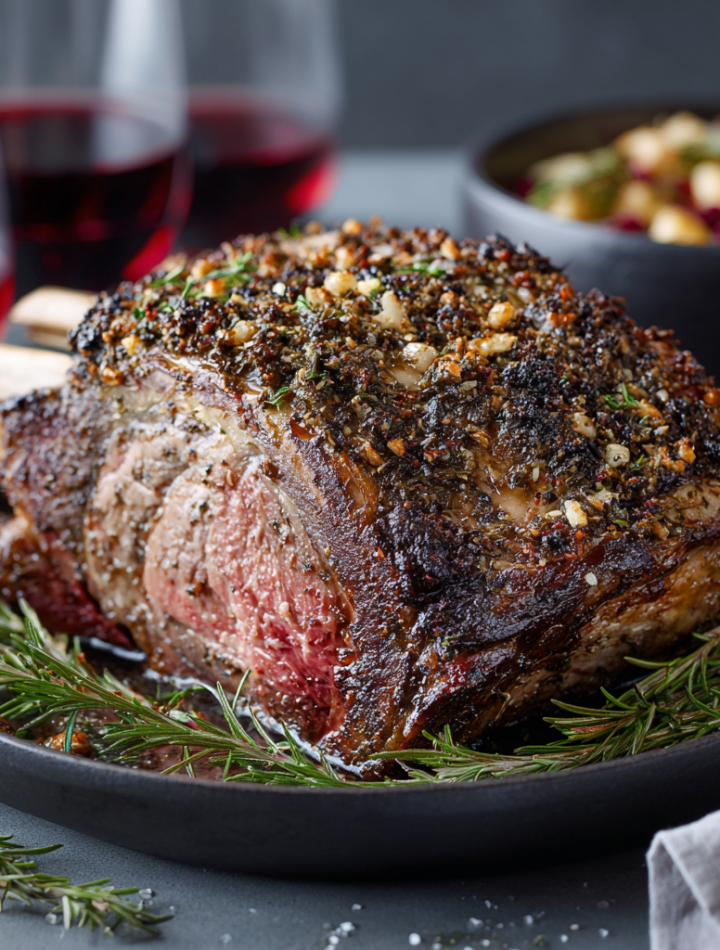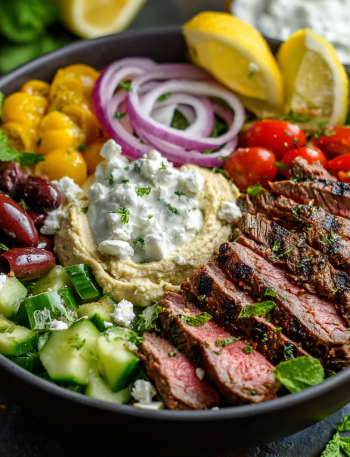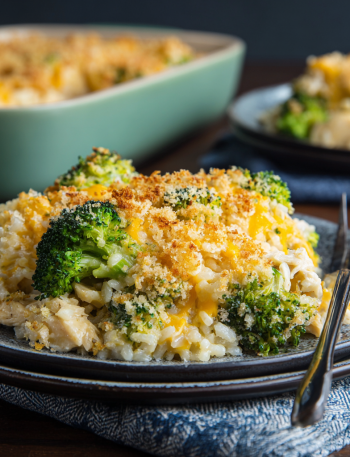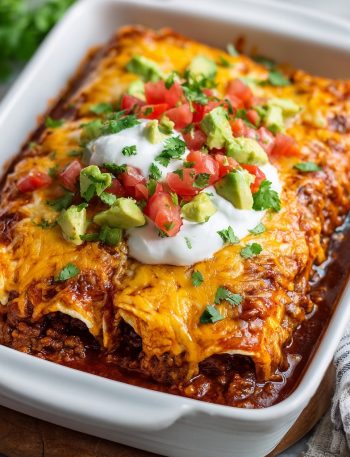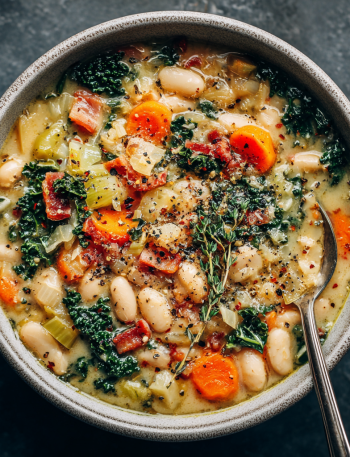
The Ultimate Christmas Prime Rib: Your New Holiday Showstopper
Hey friends, Clara here! Can you smell it? That intoxicating, savory, herbaceous scent that can only mean one thing: prime rib is roasting in the oven. It’s the kind of aroma that wraps around your home like a warm hug, signaling to everyone that something truly special is about to happen. If the holiday season had a signature scent (beyond pine and cookies, of course), I’m convinced it would be garlic, rosemary, and beautifully roasted beef.
Now, I know what some of you might be thinking. A standing rib roast can feel a little… intimidating. It’s the grand centerpiece, the star of the show. It can feel like there’s a lot of pressure to get it *just right*. But I’m here to let you in on a little secret: making a perfect, juicy, mind-blowingly delicious prime rib for Christmas is actually one of the most straightforward, forgiving, and rewarding things you can do in the kitchen. Seriously!
This isn’t about fussy techniques or a million steps. It’s about honoring a magnificent cut of meat with simple, powerful flavors and a little bit of kitchen confidence. We’re talking a low-and-slow roast that guarantees even cooking from edge to edge, a quick, high-heat sear to create that dreamy, flavorful crust, and a glorious red wine pan sauce (au jus, if we’re being fancy) that will have your guests asking for straws. This recipe is my holiday gift to you—a foolproof path to a meal that feels luxuriously decadent but is nourishingly real. So, take a deep breath, put on your favorite holiday playlist, and let’s cook a Christmas memory together.
A Prime Rib Christmas Eve: The Year of the “Oops”
My love affair with prime rib started not with a perfect success, but with a wonderfully memorable “oops.” I was about 22, hosting my very first Christmas Eve dinner for my family. I was determined to prove I was a “real adult” now, and what says “I have my life together” more than a massive, beautiful rib roast? I’d saved up, researched endlessly, and was buzzing with nervous energy.
The roast was in, the house smelled incredible, and I was following my temperature probe like a hawk. My dad, the king of well-done meat (bless him), kept peeking into the kitchen. “You sure it’s not done yet, kiddo? Looks a little… pink.” I stood my ground, promising him it would be perfect. The moment of truth arrived. I pulled it out, let it rest (agony!), and finally carved into it. It was a gorgeous medium-rare… except for the very first slice, which was practically still mooing. My dad’s eyes lit up. “Now THAT’S a piece of meat!” he declared, claiming it immediately. That “mistake” ended up being his favorite part of the meal, and it taught me a beautiful lesson: holiday cooking isn’t about rigid perfection. It’s about the joy, the shared experience, and sometimes, the happy accidents that become the best stories. This recipe is designed to give you that beautiful, even cook, but it’s also a reminder to relax and enjoy the process.
Print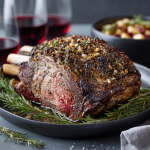
Tasty Christmas Prime Rib
- Total Time: 2 hours 20 minutes
- Yield: 8–10 1x
Description
Prime rib is the ultimate holiday centerpiece — tender, juicy, and full of rich beef flavor. Roasted low and slow, then finished with a flavorful herb crust, this Christmas version gets an extra festive touch with garlic, rosemary, and a splash of red wine in the pan juices. A true showstopper for your holiday feast.
Ingredients
1 standing rib roast (5–6 lbs), bone-in
4 tbsp olive oil
6 cloves garlic, minced
2 tbsp fresh rosemary, chopped
1 tbsp fresh thyme leaves
2 tsp coarse salt
1 tsp freshly cracked black pepper
1 cup red wine
1 cup beef stock
Instructions
Prep roast: Bring prime rib to room temperature (about 2 hours out of the fridge). Preheat oven to 450°F (230°C).
Season: Mix olive oil, garlic, rosemary, thyme, salt, and pepper. Rub mixture all over the roast.
Sear: Place roast bone-side down in a roasting pan. Roast at 450°F for 20 minutes to develop a crust.
Slow roast: Reduce oven temperature to 325°F (165°C). Pour wine and beef stock into the bottom of the pan. Continue roasting 1 ½–2 hours, or until internal temp reaches:
120°F for rare
130°F for medium-rare
140°F for medium
Rest: Remove from oven, tent with foil, and rest for 20–30 minutes before carving.
Make au jus: Skim fat from pan juices, then simmer on the stovetop until slightly reduced. Serve alongside slices.
- Prep Time: 20 mins
- Cook Time: 2 hours
- Category: Dinner
Nutrition
- Calories: 520
- Fat: 38g
- Protein: 42g
Gathering Your Prime Rib Dream Team
Here’s everything you’ll need to create this masterpiece. The beauty is in the simplicity of these ingredients—each one plays a crucial role in building layers of flavor.
- 1 standing rib roast (5–6 lbs), bone-in: This is the star! Ask your butcher for a “standing” rib roast, which means the bones are left on, acting as a natural roasting rack for even heat distribution and adding incredible flavor. The bone-in also helps protect the meat, keeping it extra juicy. Plan for about one rib bone for every two people.
- 4 tbsp olive oil: Our flavor-delivery vehicle! A good, robust extra virgin olive oil will create a base for our herb crust to stick to and will help it get beautifully golden and crisp.
- 6 cloves garlic, minced: Is there anything more comforting than the smell of roasting garlic? It mellows and sweetens in the oven, infusing the beef with its essence. Don’t be shy here!
- 2 tbsp fresh rosemary, chopped: Rosemary and beef are a match made in heaven. Its piney, robust flavor can stand up to the rich meat. Chef’s Insight: Rub the chopped rosemary between your palms before adding it to the mix—this releases its fragrant oils!
- 1 tbsp fresh thyme leaves: Thyme adds a subtle, earthy complexity that complements the rosemary beautifully. If you can only find one herb, rosemary is the non-negotiable, but thyme is a wonderful supporting actor.
- 2 tsp coarse salt (like kosher salt): Coarse salt is key because it creates little pockets of seasoning and doesn’t dissolve immediately, giving you a better crust. This might seem like a lot, but a large roast needs ample seasoning to taste amazing.
- 1 tsp freshly cracked black pepper: Freshly cracked has a brighter, more pungent aroma than pre-ground. It’s worth the extra effort!
- 1 cup red wine: This is for our pan sauce! A dry, full-bodied red like a Cabernet Sauvignon or Merlot works wonderfully. Substitution Tip: No wine? No problem. You can use an additional cup of beef stock mixed with a teaspoon of red wine vinegar or balsamic glaze for acidity.
- 1 cup beef stock: Use a good-quality stock for the best flavor foundation for your au jus. This, combined with the pan drippings and wine, will create liquid gold.
Let’s Get Roasting: Your Foolproof Step-by-Step Guide
Okay, team. This is where the magic happens. Read through these steps once before you start—it’s all about timing and confidence. You’ve got this!
- Prep the Roast (The Most Important Step!): About 2 hours before you plan to cook, take the prime rib out of the refrigerator. Unwrap it, pat it completely dry with paper towels (this is crucial for a good sear!), and let it sit on the counter on a plate. Why? A room-temperature roast cooks much more evenly than an ice-cold one. If you skip this, the outside will be overcooked before the center comes to temperature. This is non-negotiable for prime rib perfection! While it’s coming to temp, preheat your oven to a blazing hot 450°F (230°C).
- Create & Apply the Flavor Paste: In a small bowl, mix together the olive oil, minced garlic, chopped rosemary, thyme leaves, coarse salt, and cracked pepper. It should form a fragrant, coarse paste. Now, get in there with your hands and massage this mixture all over the entire surface of the roast. Don’t forget the ends! This isn’t a gentle drizzle; it’s a full-bodied rub that will create your crust. Chef’s Hack: If you have time, you can do this right after you take the roast out of the fridge. Letting it sit with the seasoning for those 2 hours allows the flavors to penetrate even more deeply.
- The Searing Blast: Place the roast bone-side down in a large roasting pan. The bones act as a natural rack, but if your cut is boneless or you’re worried, you can place a wire rack inside the pan. Slide the roast into the preheated 450°F oven and let it roast for 20 minutes. This initial high heat will sear the outside, creating that beautiful, flavorful crust we’re after. Your kitchen will smell amazing.
- The Low & Slow Magic: After 20 minutes, without opening the oven door, reduce the oven temperature to 325°F (165°C). Carefully pour the red wine and beef stock into the bottom of the roasting pan (avoid pouring it directly over the crusty top). These liquids will steam and create a humid environment, keeping the roast moist, and they’ll form the base of our incredible sauce. Now, let the roast do its thing. Roast for approximately 1 ½ to 2 hours. But here’s the real key: cook to temperature, not to time. Ovens vary, so a reliable meat thermometer is your best friend.
- Check the Temperature: Start checking the internal temperature about 1 hour into the low-temperature cooking. Insert the thermometer into the center of the roast, making sure not to touch bone or fat.
- 120°F (49°C) for Rare (very red and cool center)
- 130°F (54°C) for Medium-Rare (warm red center) – This is my recommended sweet spot for the most tender and juicy result!
- 140°F (60°C) for Medium (warm pink center)
Remember, the temperature will continue to rise about 5-10 degrees while resting (this is called “carryover cooking”).
- The Sacred Rest: Once your roast hits about 5-10 degrees below your desired final temperature, take it out of the oven. Transfer it to a clean cutting board and tent it loosely with aluminum foil. Let it rest for at least 20-30 minutes. I know, I know—it’s torture to wait! But this is critical. Resting allows the muscle fibers to relax and reabsorb all those glorious juices. If you cut into it right away, all the juice will run out onto the cutting board, leaving you with dry meat. Trust me on this!
- Carve and Serve: After resting, it’s time for the grand finale! To carve, turn the roast so the bones are facing up. Use a sharp carving knife to slice along the bones to separate them from the main muscle. Then, turn the boneless roast on its side and slice it into beautiful, thick (½ to 1-inch) slices. Serve immediately.
- Make the Simple Au Jus: While the meat is resting, don’t forget the pan drippings! Place the roasting pan on the stovetop over medium heat. The pan will be hot, so be careful. Skim off most of the clear fat that has risen to the top. Use a whisk to scrape up all the browned, flavorful bits stuck to the bottom of the pan (this is called “fond,” and it’s pure flavor gold!). Let the liquid simmer and reduce for a few minutes until it slightly thickens. Strain it into a gravy boat for a smooth, elegant sauce.
How to Plate Your Holiday Masterpiece
Presentation is part of the fun! I love serving prime rib family-style on a large, warm platter. Arrange the slices slightly overlapping, and don’t forget to include those delicious rib bones for anyone who loves a little extra gnawing (a coveted treat!). Pour a little of the au jus over the sliced meat on the platter to keep it glistening and moist, and serve the rest on the side. This is a rich, celebratory dish, so I like to keep the sides vibrant and fresh to balance it out. Think creamy mashed potatoes to soak up the jus, something green like roasted Brussels sprouts or a crisp arugula salad, and maybe a tangy horseradish cream sauce for those who want an extra kick.
Get Creative! Flavor Twists & Dietary Swaps
Once you’ve mastered the classic, feel free to play!
- Coffee & Chili Rub: Add 1 tbsp of finely ground coffee and 1 tsp of chipotle chili powder to the herb paste for a deep, smoky, and slightly spicy crust.
- Mustard & Herb Crust: Swap 2 tbsp of the olive oil for Dijon mustard in the paste. It adds a wonderful tang and helps the herbs adhere even better.
- Simple Salt & Pepper: For the purist, sometimes less is more. A generous coating of only salt and pepper lets the incredible flavor of the beef itself shine through.
- Boneless Variation: You can absolutely use a boneless rib roast. Just tie it with kitchen twine at 1-inch intervals to help it keep its round shape for even cooking. Cooking times will be slightly shorter, so rely on your thermometer.
- Herb Swap: Try fresh sage or marjoram in place of (or in addition to) the thyme for a different aromatic profile.

Clara’s Final Thoughts & Kitchen Confessions
This recipe has been my holiday rock for years. It’s evolved from that slightly nerve-wracking first attempt into a relaxed, annual tradition. The biggest change I’ve made? Investing in a good digital meat thermometer. It took the guesswork out completely and gave me the confidence to stop second-guessing myself. My other confession? I always sneak a tiny piece of the herb crust that falls off into the pan juices. It’s my little chef’s treat while I’m finishing the au jus. The journey to this “perfect” prime rib was paved with a few undercooked and overcooked experiments, but each one was delicious in its own way and shared with people I love. That’s the real secret ingredient, isn’t it? So, don’t stress. Embrace the process, enjoy the smells, and get ready for the applause.
Your Prime Rib Questions, Answered!
Let’s tackle some common questions head-on so you feel 100% prepared.
Q: Help! My herb crust is burning before the inside is cooked! What did I do wrong?
A: This usually happens if the initial searing temperature is too high, or if the oven runs hot. If you see the crust getting too dark during the low-and-slow phase, you can tent the roast loosely with foil for the remainder of the cooking time. This will protect the crust while allowing the heat to penetrate the center.
Q: Can I prepare the prime rib the day before?
A: Absolutely! This is a fantastic time-saver. The night before, pat the roast dry, apply the herb-oil rub, and place it on a plate in the refrigerator, uncovered. This actually helps the skin dry out further, promoting an even better crust. Just remember to take it out 2-3 hours before cooking to come to room temperature (it will take longer since it’s fridge-cold).
Q: Why is there so much liquid in my pan? Did I do something wrong?
A> Nope, you’re doing great! A significant amount of liquid in the pan is totally normal. It’s a combination of the wine, stock, and rendered fat and juices from the roast itself. This is a good thing—it means your au jus will be incredibly flavorful. Just be sure to skim off the excess fat (the clear oil that rises to the top) before reducing it on the stovetop.
Q: I can’t find a bone-in roast. Will a boneless one work?
A: Yes, a boneless rib roast (sometimes called a ribeye roast) will work beautifully. Just follow the note in the “Variations” section about tying it with twine to maintain its shape. Because the bones aren’t there to act as an insulator, the cooking time might be a bit faster, so keep a close eye on that internal temperature from the 1-hour mark onward.
Nutritional Information*
Per Serving (approx., based on 10 servings): 520 calories | 38g fat | 2g carbs | 42g protein
